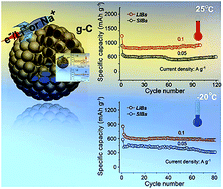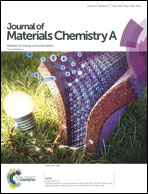Target construction of ultrathin graphitic carbon encapsulated FeS hierarchical microspheres featuring superior low-temperature lithium/sodium storage properties†
Abstract
Although numerous electrode materials based on conversion-reactions have been investigated for lithium/sodium ion batteries (L/SIBs), the low-temperature performance is still a big challenge for their practical application in cold climates. Herein, every individual small FeS sphere wrapped by several graphitic carbon layers in a micro–nano system (FeS@g-C) is designed and explored. The in situ generated FeS@g-C delivers excellent electrochemical performance over a wide temperature range. For instance, the reversible capacity of FeS@g-C can reach 562 mA h g−1 at 0.2 A g−1 for LIBs at −20 °C. And for SIBs, it exhibits a capacity of 311 mA h g−1 at 0.05 A g−1 even when operated at a cryogenic temperature of −25 °C. In addition, when paired with a Na3V2(PO4)2O2F cathode as a full cell for SIBs, it also works well, revealing great application prospects. This good electrochemical performance of the FeS@g-C can be attributed to the short ion-diffusion paths provided by the ultrasmall FeS nanospheres along with the more important g-C coating, which guarantees the high conductivity of FeS@g-C. In addition, the perfectly shaped and porous hierarchical FeS spheres can effectively accommodate the volume variation during electrochemical processes, thus endowing the FeS@g-C with a robust structural stability.



 Please wait while we load your content...
Please wait while we load your content...